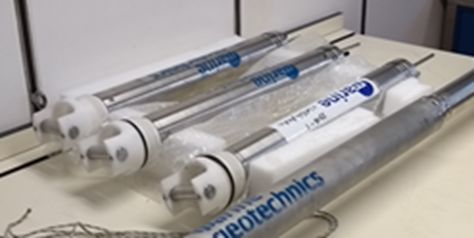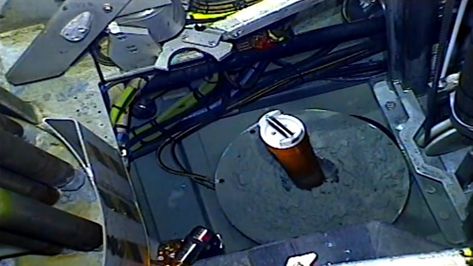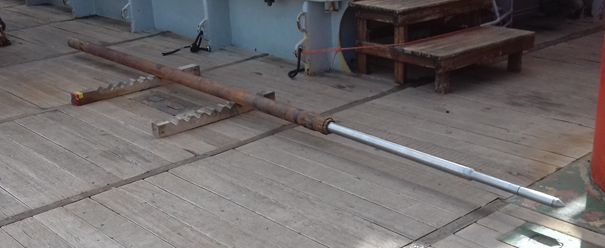- Marine Geotechnics
- Cruises
- Meteor 149
- Weekly Reports
Weekly Reports
Week 1
The goal of Expedition M149 is to study tectonic activity and flow flow associated with the plate boundary between Eurasia and Africa. The expedition goals will be implemented through a comprehensive sampling program that includes drilling into mud volcanos and fault zones using the seafloor drill rig (Meeresboden-Bohrgerät) MeBo, insitu heat flow measurements and installation of long-term observatories into the sub-seafloor in the Gulf of Cadiz and the Alboran sea (e.g. Carboneras and Al-Idrise faults). Mud volcanos are edifices build-up by material originating from several kilometers depth and thus allow insight into processes occurring deeply along the plate boundary fault. The long-term observatories are designed to record pore water pressure and temperature over years to study the activity of mud volcanos and faults in relation to the regional tectonics.
After extensive operations in the port of Las Palmas (Gran Canaria), well into the evening of July 24, Expedition M149 with research vessel Meteor started on July 25. After leaving port the vessel steamed to the Gulf of Cadiz and arrived in the study area in the evening of July 27. During the night the seafloor was mapped using the ship intern multibeam and parasound systems, which was continued the following nights. On Saturday two mud volcanos and the surrounding seafloor were sampled using a gravity corer. For gas and fluid analysis the scientists collected sediment and fluid samples immediately after the gravity corer was retrieved onboard. In addition detailed sedimentological descriptions and biostratigraphic and physical properties analyses are performed onboard.
On Sunday morning the seaflor drill rig MeBo was deployed but was retrieved shortly after due to technical issues. Aim of the MeBo campaign was an extensive drilling program that included sampling, temperature measurements and the installation of an observatory into the summit of a mud volcano. Instead, heat flow measurements were conducted throughout the day to detect areas of active fluid flow.
Andre Hüpers (Chief Scientist) on behalf of the entire science party

Week 2
At the beginning of week 2 we continued with the heat flow profile across a mud volcano and an adjacent NW-SE trending strike-slip fault. On Tuesday the drill rig MeBo was again deployed to drill into the crest of a mud volcano and install a long-term observatory. Due to problems with the hydraulic system the drilling was aborted at a depth of 2.8m below seafloor. The remainder of the day was spend with additional gravity coring of a mud volcano to validate preliminary results of the onboard measurements. The gravity coring continued the next day with sampling the strike-slip fault previously investigated with the heat flow probe. Installation of the observatory was finally successful on Friday after drilling 18m into the summit of the mud volcano „Ginsburg“ and closing the borehole with an observatory. The observatory will log the pressure and temperature in the borehole over the next few years and document the activity of the mud volcano.
After the successful MeBo deployment, the gravity coring was resumed to sample another NW-SE trending strike-slip fault that crosses the entire Golf of Cadiz further south. By the end of the second week, 30 gravity cores have been taken with a total length of ~90m. The MeBo drilling on the mud volcano „Ginsburg“ returned another 7.7m. In addition, the seafloor mapping with the ship-intern multi-beam system covers an area of approximately 3000km2 by now. Currently the MeBo is on the seafloor again to test a prototype of a MARUM developed cone penetration testing (CPT) device. After the test, the drill rig will be moved slightly to drill and sample the outer rim of the „Ginsburg“ mud volcano to 20m below seafloor.
Andre Hüpers (Chief Scientist) on behalf of the entire science party



Week 3
During Sunday night the prototype of a cone penetration testing (CPT) device was successfully tested during a deployment of the sea floor drill rig MeBo. The CPT probe was pushed 30m into the seafloor und recorded the force acting on the tip and sleeve of probe as well as the pore water pressure. A dissipation test was conducted at 6 and 30m below seafloor, respectively, to determine the in situ pore water pressure in the sediment. The subsequent drilling of the outer rim of the „Ginsburg“ mud volcano was aborted due to problems with the hydraulic system. On Monday the NW-SE trending strike-slip faults „Lineament Center“ and „Lineament South“ were sampled with the gravity corer accompanied by heat flow measurements in this area. The MeBo was deployed again on Wednesday and drilled eventually 40m into the outer rim of the mud volcano „Ginsburg“ with a core recovery of 92%.
On Thursday the sea floor drill rig was deployed at the „Lineament Center“ and the borehole reached the target depth of 20m below seafloor and was successfully closed with a long-term observatory. This is the second observatory that was installed during this expedition in the Gulf of Cadiz. These two observatories will provide important information on the activity of mud volcanoes and fault zones in this region in the next few years. During the weekend MeBo drilled 50m into a pull-apart basin along the „Lineament Center“, sampling a sediment succession that will provide information on the activity of the strike-slip fault in the past. Between the MeBo deployments further mud volcanoes were sampled using the gravity corer – including two newly discovered mud volcanoes, which the participants named „R2“ and „D2“.


Week 4
After the successful mission of the seafloor drill rig MeBo last weekend the device was again deployed on Monday. The aim of the drilling mission was to sample another pull-apart basin – this time along the “Lineament South”. In combination with sediment cores from the “Lineament Center”, the activity of these strike-slip faults and the general tectonic history of the Gulf of Cadiz region may be unraveled based on the lithostratigraphic record of the recovered sediment sequences.
The last gravity cores in the area of the strike-slip faults were taken on Tuesday including cores from potential mud volcanoes. From there the research vessel Meteor moved first to the deep sea, where salt diapirs in the „Seine“ abyssal plain were sampled and then steamed to the Alboran sea. During the transit across the Gulf of Cadiz additional gravity cores from potential mud volcanoes were taken. At least one new mud volcano was discovered during the two days of transit and has been named „Funky Monkey“.
Since Friday afternoon the R/V Meteor is in the Alboran sea to study the hydrogeological and tectonic activity of faults. The first study object is the „Carboneras“ fault, which is a NE-SW trending strike-slip fault, which continuous from the land into the Mediterranean sea. It is planned to install the third long-term borehole observatory along the fault. To determine the best location for the observatory a combination of seafloor mapping, sediment sampling via gravity coring and heat flow measurements is currently underway.
Andre Hüpers (Cief Scientist) on behalf of all participants
Week 5
After a pre-survey of the Carboneras fault, Gulf of Almeria off S Spain, by seafloor mapping, gravity coring and heat flow measurements, the seafloor drill rig MeBo was deployed for the last time during Expedition M149 and sampled the sediment down to 20 m below seafloor. The recovered core shows multiple high angle faults, evidence for the deformation of the sediment through strike-slip faulting. The borehole was closed with a long-term observatory to measure pressure and temperature variations in response to the sediment deformation in the next few years. Furthermore, the Al-Idrissi fault, a strike-slip fault offshore Morocco, was investigated by gravity coring and heat flow measurements and preliminary analysis indicate a hydrogeological activity of the fault. At the end of the Expedition a buried mass transport deposit was discovered during a multibeam and parasound survey. Post-expedition analysis will show if the mass wasting caused a tsunami in the Mediterranean sea. Research vessel Meteor arrived in the morning of August 24 in the port of Cadiz. All participants of expedition M149 thank the captain and the crew of R/V Meteor for their support, which immensely contributed to the success of the expedition.
Andre Hüpers (Chief Scientist) on behalf of the M149 participants


